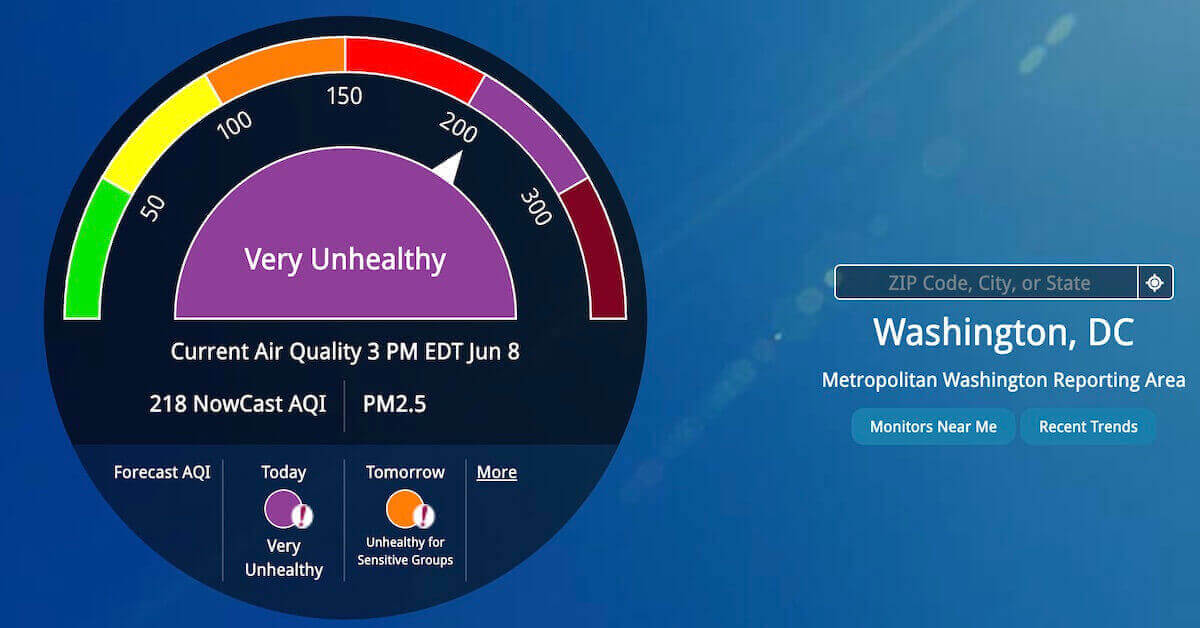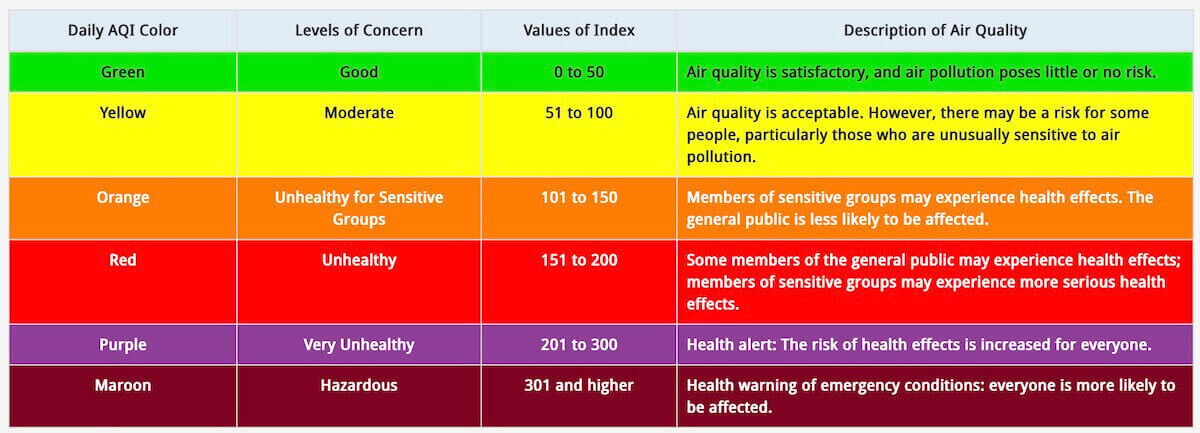The Office of Personnel Management is urging agencies to let federal employees telework to combat the poor air quality conditions in the Washington, DC area stemming from the Canadian wildfires.
In a memo issued on Thursday, June 8, 2023, OPM director Kiran Ahuja wrote, “Agencies are encouraged to permit employees, particularly those with high-risk medical conditions, to telework from home on a day when air quality conditions are dangerous.”
The memo further adds, “Additionally, if permitted by agency policy, an employee working a flexible work schedule may choose to adjust arrival and departure times to avoid commuting during hours when the air quality may be worse. Employees may also request the use of annual leave, earned compensatory time off, or credit hours on a day when the air quality is threatening to an employee’s health and welfare.”
A copy of the memo is included further below.
On the same day the memo was issued, the Metropolitan Washington Council of Governments and District Department of Energy and Environment (DOEE) issued a “Code Purple” air quality alert for Washington, DC. The Code Purple air quality alert means that air quality conditions in the metro area are potentially unsafe for the general public and not just those with respiratory illnesses.
The current air quality rating for Washington, DC from AirNow.gov confirmed the statement from DOEE. As of the time of this writing, the score was showing a little bit over 200 which it labeled as “very unhealthy.”

There are six categories on the Air Quality Index (AQI) to categorize levels, and higher values indicate more hazardous conditions. AirNow.gov states, “When AQI values are above 100, air quality is unhealthy: at first for certain sensitive groups of people, then for everyone as AQI values get higher.”

People are encouraged to stay inside as much as possible until the air quality improves. Anyone who must be outside is encouraged to wear an N95 or KN95 mask.
Also as of the time of this writing, OPM has not changed the operating status on its website. It currently shows the status as “open.” That may change in light of the new purple air quality alert.
Canadian Wildfires May Be Worst on Record
The air quality problems in the DC area are caused by over 400 raging wildfires in Canada, about a third of which are in Quebec. Winds have been pushing the smoke south into the United States creating hazardous conditions in cities like New York, Philadelphia, and Washington.
Canadian officials said that this could be the worst wildfire season on record. At least 6.7 million acres have already burned since the season began.
New York City was warning residents to stay inside and plans to make 400,000 N95 masks available at state facilities within the city. The air quality index rose as high as 484 out of 500 at 5 PM EST on Wednesday, June 7. However, as of 3 PM EST on Thursday, it had declined back to 164.
OPM Memo Encouraging Telework Due to Canadian Wildfires
Dangerous Air Quality Conditions Due to Canadian Wildfires
MEMORANDUM FOR: CHIEF HUMAN CAPITAL OFFICERS
From: Kiran A. Ahuja, Director, U.S. Office of Personnel Management
Subject: Dangerous Air Quality Conditions Due to Canadian Wildfires
Thursday, June 8, 2023
As much of the country experiences dangerous air quality conditions from the ongoing Canadian wildfires, the U.S. Office of Personnel Management (OPM) is reminding Federal agencies to be proactive in protecting the health and wellbeing of our Federal workforce. In particular, we strongly encourage agencies to take all available steps to help protect those employees with high-risk medical conditions when dangerous air quality conditions are present. Employees are strongly encouraged to monitor their local air quality index levels through the AirNow website.
OPM would also like to remind agencies of the various workplace flexibilities that may be used to reduce health risks associated with dangerous air quality levels. Agencies are encouraged to permit employees, particularly those with high-risk medical conditions, to telework from home on a day when air quality conditions are dangerous. Additionally, if permitted by agency policy, an employee working a flexible work schedule may choose to adjust arrival and departure times to avoid commuting during hours when the air quality may be worse. Employees may also request the use of annual leave, earned compensatory time off, or credit hours on a day when the air quality is threatening to an employee’s health and welfare. The following links provide additional information on available workplace flexibilities:
Any decision to change the operating status of a Federal office or facility due to dangerous air quality conditions should be made consistent with the operating status announcements and guidance found in OPM’s Governmentwide Dismissal and Closure Procedures. This includes the proper application of weather and safety leave, unscheduled telework, and unscheduled leave for employees. Please note that OPM issues operating status announcements that apply only to those employees working in Executive agencies with offices located inside the “Washington Capital Beltway” (i.e. the Washington, DC area). Employees working in Federal agency offices located outside of the Washington Capital Beltway must follow operating status announcements issued by their agency. The current Washington, DC area operating status can be found on OPM’s website or by downloading the OPM Alert Mobile App.
Finally, OPM wants to make the Federal community aware of the resources available from various Federal health authorities that provide information and advice on the best ways to cope with dangerous air quality conditions to protect ourselves and our families. The following links to official Federal Government information may be helpful:
- The Environmental Protection Agency’s (EPA) AirNow Fire and Smoke Map which gives the public information on fire locations, smoke plumes, near real-time air quality and actions to take to protect your health all in one place.
- The EPA’s AirNow app, available for free on the Apple App Store and Google Play Store, can be used to check the AirNow Fire and Smoke Map by tapping the Smoke icon in the app.
- EPA’s AirNow guidance on ways to reduce exposure when smoke is in the air.
- The Centers for Disease Control and Prevention guidance on air quality and wildfire smoke.
- The Department of Health and Human Service’s Office of Climate Change and Health Equity guidance on the current wildfire outlook.
Additional Information
For additional information, agency headquarters-level human resources offices may contact OPM at pay-leave-policy@opm.gov. Component-level human resources offices must contact their agency headquarters for assistance. Employees must contact their agency human resources office for further information on this memorandum.


